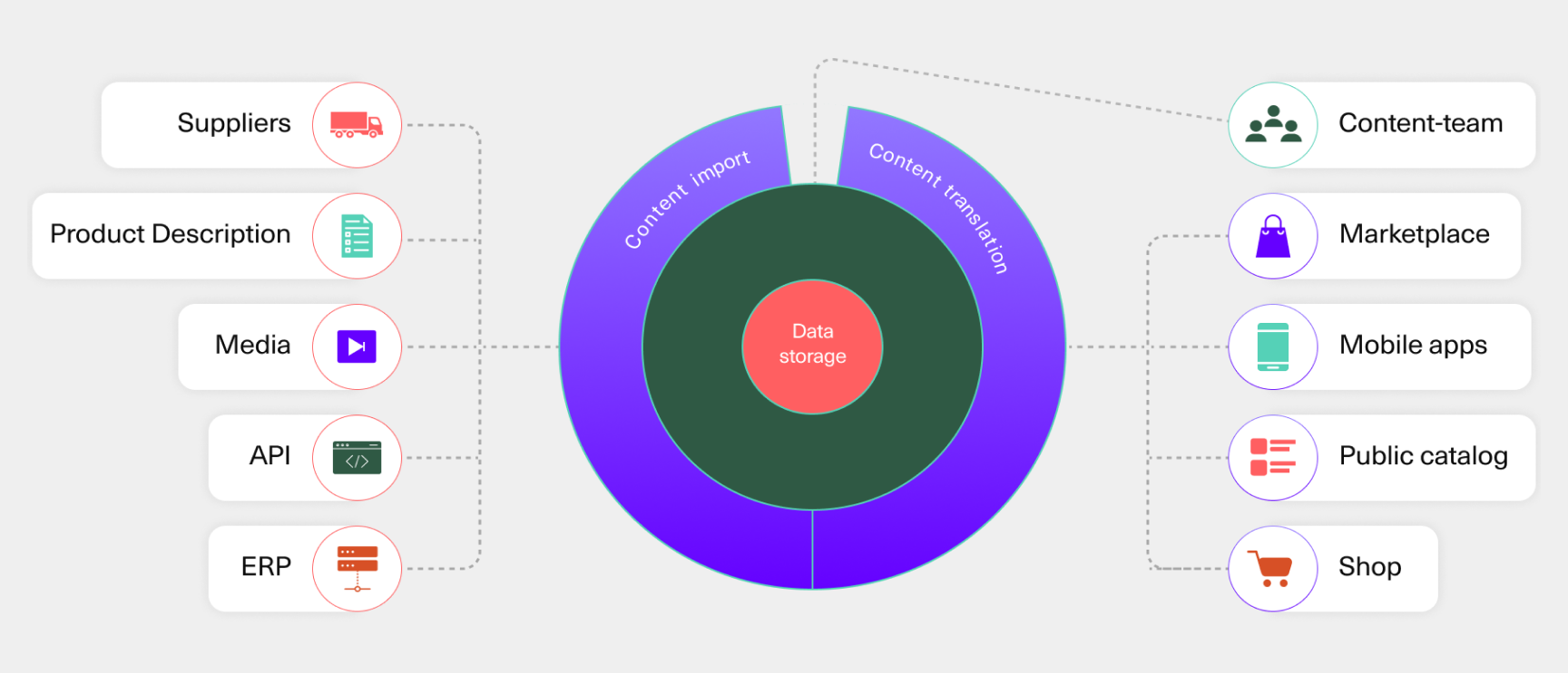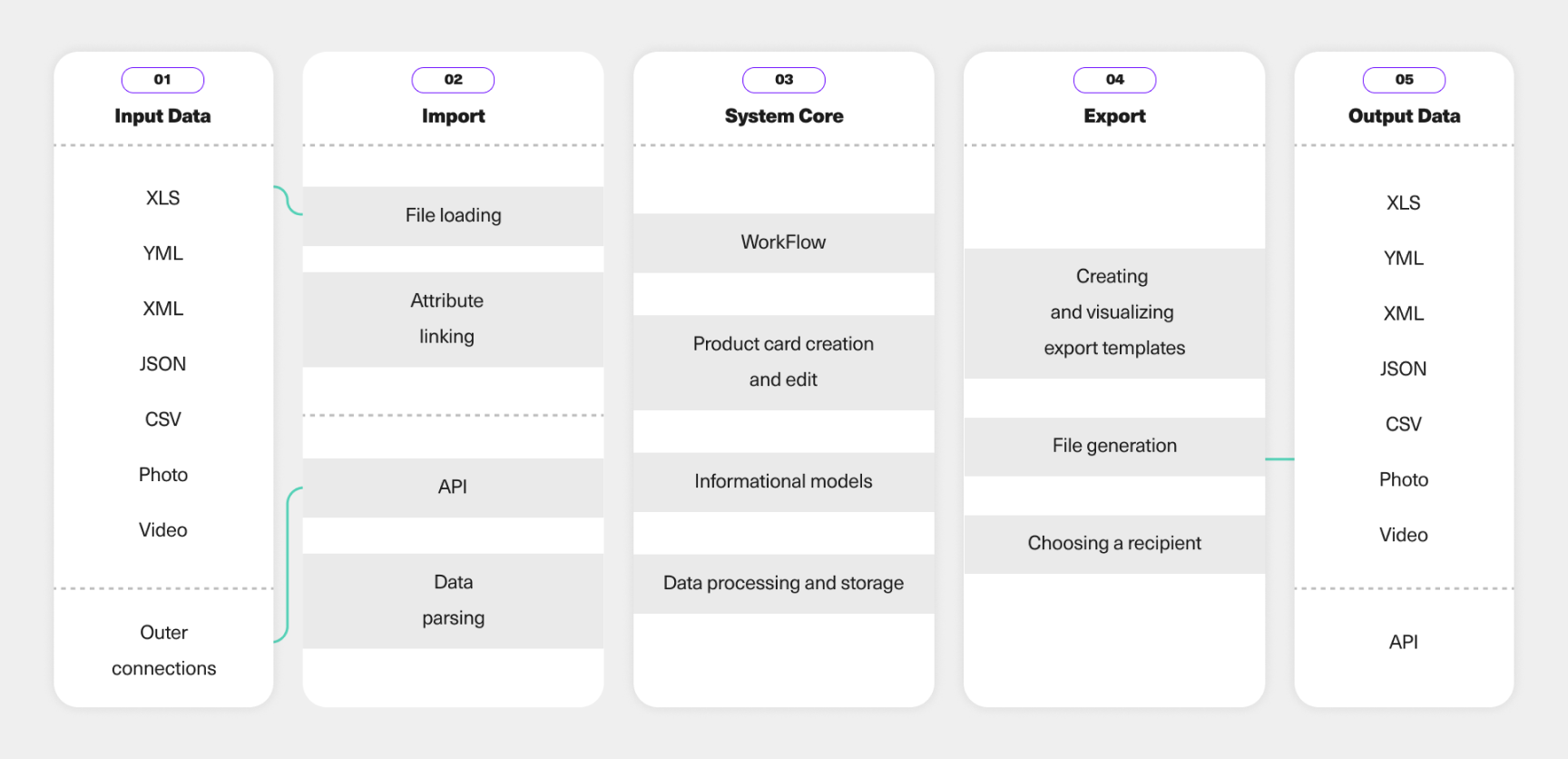What is a PIM system?
PIM-system (Product Information Management System) is a system for managing product content, software that provides storage, easy development and enrichment of product information, the creation and transformation of product cards information models, the broadcast of information about products in the format required by the consumers of content.
The PIM system manages the process of processing content and other product information that are necessary for promotion to the market, ensures the development of the most complete data for internal use and multi-channel distribution. The PIM system allows businesses to be confident in the reliability of data on products distributed to various sales channels.
PIM system provides a single common space for the work of all participants in the process associated with product content. The platform allows you to reduce operating costs by saving the time of all employees involved in the preparation of product content, thereby speeding up the launch of products and the quick connection of new sales channels in e-commerce.

What product information is managed by the PIM system?
There are various PIM system data formats that are required for a product throughout the life cycle of an e-commerce product. The PIM system allows work with information about the product and enable to process the incoming and outgoing flow of various types of product content for various sales channels:
· Basic product data in PIM: SKUs, EAN/UPC, names, titles, manufacturers, brands, descriptions, country of manufacture, product type.
· Taxonomy and relationships: categories, labels, variations.
· Specifications: logistics parameters, materials, ingredients, guarantees.
· Media files: images, videos, documents.
· Marketing data: keywords, audiences, unique selling proposition, SEO elements.
Sales information: prices, reviews, analytics indicators
· Specifications: style and size charts, designer notes, assembly instructions, worksheets.
· Information related to a specific sales channel. For instance, different categories of marketplaces, names for each of the sites, internal IDs, number of characters in titles, the relationship between products, a system for converting data on attribute values, characteristics and descriptions of product cards.
· Localized information about multilingual copies, translations, regional packaging formats.
· Supplier and manufacturer data: spreadsheets, certificates, production information, supplier data.
What can be done with the PIM system? Why is PIM needed?
Fortunately, there are many types of merchandising content management software with industry-specific and generic solutions and customization options for companies that are ready for digital transformation. The PIM tools allow companies to consolidate their product catalog and information database into one manageable storage. PIM system is the “single source of truth” about a product. There are local and cloud solution for storing data in a PIM.
PIM system allows you to:
- Centralize and organize segmental product data
- Systematize the product catalog, organize its optimal structure and hierarchy
- Improve product descriptions and collect full specifications and all product information
- Track work progress
- Collaborate between different departments, suppliers, teams, contractors in a single space of PIM
- Match images, documents and files to specific products in the catalog
- Categorize products and files
- Collect and prepare data for sales channels into information models suitable for them
- Manage interconnections between products
- Create product table uploads
- Automate the creation and maintenance of an online catalog for external users access
- Create a source of trustworthy data in one central database of the PIM system

What are the benefits of a PIM system?
PIM system will be effective for companies regardless of the number of products and the depth of product data. The benefits of content management systematizing become especially noticeable when it comes to productivity. A PIM system will save time for the team, improve data quality, and give full control over the content teem’s work. Enriched, consistent, customer-friendly product data across every sales channel will drive conversions and increase customer loyalty.
The introduction of a PIM system for product content management, in addition to saving operating costs, will allow you to:
- Reduce errors and duplications of data by relying on the “single source of truth” about products
- Eliminate manual data entry and errors for each sales channel
- Increase the number of SKUs offered, while drastically reducing time-to-market, eliminate bottlenecks and scatted data
- Create complete and consistent content, optimized for all sales channels
- Improve the visibility of product cards in search results and drive additional traffic to your website
- Sell more with user-friendly content and accessible data
- Promptly expand the range of products
- Reduce the number of product returns and technical support calls
- Identify products cards that need to be enriched with information to achieve maximum ROI
Who needs PIM systems?
- Manufacturers who need to convey information about products to their consumers quickly and without errors
- Sales departments who constantly need accurate product information and materials to interact with a customers
- E-commerce managers who need to constantly update content, improve user experience and increase conversion rates
- Marketing teams who have to manage a large amount of content to create and modify campaigns across multiple channels
- Your customers who can buy with confidence knowing they can rely on your brand’s product information
What business formats can PIM systems be used for?
Companies of any size can benefit from this type of product information management software. However, a PIM system becomes an important tool when your company:
- Manages complex content
- Has a large number of SCUs
- Sells products through multiple channels
- Collects data from multiple providers
- Requires accurate product information available to multiple teams
- Suffering from too many manual processes
- Expands or changes the range of products many times a year
A PIM system is an ideal data management and automation system for product information for manufacturers, distributors and agencies creating content for e-commerce.
If you work with a large number of categories and product ranges with numerous characteristics, descriptions, media content and metadata, employees at different levels, various departments and external contractors are involved in the work on product cards, you plan to expand distribution channels, then the PIM system is a must-have tool for you.
The time for processing of one product card is reduced by 4-5 times if a business uses a PIM system to work with product content.
Nowadays, when the requirements for the quality of product information and accuracy in descriptions are increasing, the use of a PIM system is becoming a must for use in all types of organizations at different stages of a product’s life.